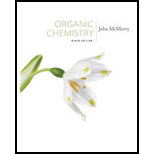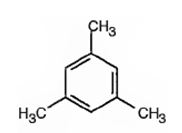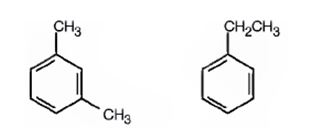
Concept explainers
Propose structures for
(a) C9H12; gives only one C9H11Br product on substitution of a hydrogen on the aromatic ring with bromine
(b) C10H14; gives only one C10H13Cl product on substitution of a hydrogen on the aromatic ring with chlorine
(c) C8H10; gives three C8H9Br products on substitution of a hydrogen on the aromatic ring with bromine
(d) C10H14; gives two C10H13Cl products on substitution of a hydrogen on the aromatic ring with chlorine
a) C9H12; gives only one C9H11Br product on substitution of a hydrogen on the aromatic ring with bromine
Interpretation:
A possible structure for the hydrocarbon with molecular formula C9H12 that gives only one monobromination product C9H11Br on substitution of a hydrogen on the aromatic ring with bromine is to be given.
Concept introduction:
All aromatic compounds are derivatives of benzene. The benzene ring accounts for six carbon atoms. The remaining carbons can be attached as alkyl group like methyl, ethyl etc. to the benzene ring.
To propose:
A possible structure for the hydrocarbon with molecular formula C9H12 that gives only one monobromination product C9H11Br on substitution of a hydrogen on the aromatic ring with bromine.
Answer to Problem 23AP
A possible structure for the hydrocarbon with molecular formula C9H12 that gives only one monobromination product C9H11Br on substitution of a hydrogen atom on the aromatic ring with bromine is

Explanation of Solution
The molecular formula of the compound is C9H12. Benzene ring accounts for six carbons. When the three carbons remaining are arranged as three methyl groups alternatively on the benzene ring the three hydrogens on the other three carbons become equivalent. Hence upon bromination, the hydrocarbon gives only one monosubstituted product.
A possible structure for the hydrocarbon with molecular formula C9H12 that gives only one monobromination product C9H11Br on substitution of a hydrogen atom on the aromatic ring with bromine is

b) C10H14; gives only one C10H13Cl product on substitution of a hydrogen on the aromatic ring with chlorine
Interpretation:
A possible structure for the hydrocarbon with molecular formula C10H14 that gives only one monochlorination product C10H13Cl on substitution of a hydrogen on the aromatic ring with chlorine is to be given.
Concept introduction:
All aromatic compounds are derivatives of benzene. The benzene ring accounts for six carbon atoms. The remaining carbons can be attached as alkyl group like methyl, ethyl etc. to the benzene ring. Only one monosubstituted product will be obtained only if all the hydrogen atoms in the aromatic ring are equivalent.
To propose:
A possible structure for the hydrocarbon with molecular formula C10H14 that gives only one monochlorination product C10H13Cl on substitution of a hydrogen on the aromatic ring with chlorine is to be given.
Answer to Problem 23AP
A possible structure for the hydrocarbon with molecular formula C10H14 that gives only one monochlorination product, C10H13Cl, on substitution of a hydrogen atom on the aromatic ring with chlorine is

Explanation of Solution
The molecular formula of the hydrocarbon is C10H14. Benzene ring accounts for six carbons. The remaining four carbons can be arranged as four methyl groups or as two ethyl groups on the benzene ring in four different ways as shown such that remaining hydrogen atoms become equivalent. Hence upon chlorination, the hydrocarbon will give only one monosubstituted product.
A possible structure for the hydrocarbon with molecular formula C10H14 that gives only one monochlorination product, C10H14Cl, on substitution of a hydrogen atom on the aromatic ring with chlorine is

c) C8H10; gives three C8H9Br products on substitution of a hydrogen on the aromatic ring with bromine
Interpretation:
A possible structure for the hydrocarbon with molecular formula C8H10 that gives three monobromination products. C8H9Br, on substitution of a hydrogen on the aromatic ring with bromine is to be given.
Concept introduction:
All aromatic compounds are derivatives of benzene. The benzene ring accounts for six carbon atoms. The remaining carbons can be attached as alkyl group like methyl, ethyl etc. to the benzene ring.
To propose:
A possible structure for the hydrocarbon with molecular formula C8H10 that gives three products, C8H9Br, on substitution of a hydrogen on the aromatic ring with bromine.
Answer to Problem 23AP
A possible structure for the hydrocarbon with molecular formula C8H10 that gives three monobromination products C9H11Br on substitution of a hydrogen atom on the aromatic ring with bromine is

Explanation of Solution
The molecular formula of the hydrocarbon is C8H10. Benzene ring accounts for six carbons. When the two carbons remaining are arranged as two methyl groups meta to each other or as an ethyl group on the benzene ring hydrogens on the other carbon atoms in the ring classify themselves into three different groups. Hence upon bromination, the hydrocarbon gives three monosubstituted products.
A possible structure for the hydrocarbon with molecular formula C8H10 that gives three monobromination products, C9H11Br, on substitution of a hydrogen atom on the aromatic ring with bromine is

d) C10H14; gives two C10H13Cl products on substitution of a hydrogen atom on the aromatic ring with chlorine
Interpretation:
A possible structure for the hydrocarbon with molecular formula C10H14 that gives two monochlorination products C10H13Cl on substitution of a hydrogen atom on the aromatic ring with chlorine is to be given.
Concept introduction:
All aromatic compounds are derivatives of benzene. The benzene ring accounts for six carbon atoms. The remaining carbons can be attached as alkyl group like methyl, ethyl etc. to the benzene ring.
To propose:
A possible structure for the hydrocarbon with molecular formula C10H14 that gives two products, C10H13Cl, on substitution of a hydrogen on the aromatic ring with chlorine.
Answer to Problem 23AP
Possible structure for the hydrocarbon with molecular formula C10H10 that gives two monobromination products, C10H13Cl, on substitution of a hydrogen atom on the aromatic ring with chlorine is

Explanation of Solution
The molecular formula of the compound is C10H14. Benzene ring accounts for six carbons. The four carbons remaining can be arranged as two ethyl groups or as an ethyl & two methyl groups or as propyl & methyl groups or as isopropyl & methyl groups on the benzene ring as shown so that the hydrogens on the other carbon atoms in the ring classify themselves into two different groups. Hence upon chlorination, the hydrocarbon gives two monosubstituted products.
A possible structure for the hydrocarbon with molecular formula C10H10 that gives two monobromination products, C10H13Cl, on substitution of a hydrogen atom on the aromatic ring with chlorine is

Want to see more full solutions like this?
Chapter 15 Solutions
Organic Chemistry - With Access (Custom)
- Identifying the major species in weak acid or weak base equilibria The preparations of two aqueous solutions are described in the table below. For each solution, write the chemical formulas of the major species present at equilibrium. You can leave out water itself. Write the chemical formulas of the species that will act as acids in the 'acids' row, the formulas of the species that will act as bases in the 'bases' row, and the formulas of the species that will act as neither acids nor bases in the 'other' row. You will find it useful to keep in mind that HCN is a weak acid. acids: 0.29 mol of NaOH is added to 1.0 L of a 1.2M HCN solution. bases: ☑ other: 0.09 mol of HCl is added to acids: 1.0 L of a solution that is bases: 0.3M in both HCN and KCN. other: 0,0,... ? 00. 18 Ar 日arrow_forwardIdentifying the major species in weak acid or weak base equilibria The preparations of two aqueous solutions are described in the table below. For each solution, write the chemical formulas of the major species present at equilibrium. You can leave out water itself. Write the chemical formulas of the species that will act as acids in the 'acids' row, the formulas of the species that will act as bases in the 'bases' row, and the formulas of the species that will act as neither acids nor bases in the 'other' row. You will find it useful to keep in mind that HF is a weak acid. acids: 0.2 mol of KOH is added to 1.0 L of a 0.5 M HF solution. bases: Х other: ☐ acids: 0.10 mol of HI is added to 1.0 L of a solution that is 1.4M in both HF and NaF. bases: other: ☐ 0,0,... ด ? 18 Ararrow_forwardIdentifying the major species in weak acid or weak base equilibria The preparations of two aqueous solutions are described in the table below. For each solution, write the chemical formulas of the major species present at equilibrium. You can leave out water itself. Write the chemical formulas of the species that will act as acids in the 'acids' row, the formulas of the species that will act as bases in the 'bases' row, and the formulas of the species that will act as neither acids nor bases in the 'other' row. You will find it useful to keep in mind that NH3 is a weak base. acids: ☐ 1.8 mol of HCl is added to 1.0 L of a 1.0M NH3 bases: ☐ solution. other: ☐ 0.18 mol of HNO3 is added to 1.0 L of a solution that is 1.4M in both NH3 and NH₁Br. acids: bases: ☐ other: ☐ 0,0,... ? 000 18 Ar B 1arrow_forward
- Using reaction free energy to predict equilibrium composition Consider the following equilibrium: 2NH3 (g) = N2 (g) +3H₂ —N2 (g) AGº = 34. kJ Now suppose a reaction vessel is filled with 4.19 atm of ammonia (NH3) and 9.94 atm of nitrogen (N2) at 378. °C. Answer the following questions about this system: rise Under these conditions, will the pressure of NH 3 tend to rise or fall? ☐ x10 fall Х Is it possible to reverse this tendency by adding H₂? In other words, if you said the pressure of NH 3 will tend to rise, can that be changed to a tendency to fall by adding H₂? Similarly, if you said the pressure of NH3 will tend to fall, can that be changed to a tendency to rise by adding H₂? If you said the tendency can be reversed in the second question, calculate the minimum pressure of H₂ needed to reverse it. Round your answer to 2 significant digits. yes no atm 00. 18 Ar 무ㅎ ?arrow_forwardIdentifying the major species in weak acid or weak base equilibria The preparations of two aqueous solutions are described in the table below. For each solution, write the chemical formulas of the major species present at equilibrium. You can leave out water itself. Write the chemical formulas of the species that will act as acids in the 'acids' row, the formulas of the species that will act as bases in the 'bases' row, and the formulas of the species that will act as neither acids nor bases in the 'other' row. You will find it useful to keep in mind that HF is a weak acid. 2.2 mol of NaOH is added to 1.0 L of a 1.4M HF solution. acids: П bases: Х other: ☐ ப acids: 0.51 mol of KOH is added to 1.0 L of a solution that is bases: 1.3M in both HF and NaF. other: ☐ 00. 18 Ararrow_forwardUsing reaction free energy to predict equilibrium composition Consider the following equilibrium: N2O4 (g) 2NO2 (g) AG⁰ = 5.4 kJ Now suppose a reaction vessel is filled with 1.68 atm of dinitrogen tetroxide (N204) at 148. °C. Answer the following questions about this system: rise Under these conditions, will the pressure of N2O4 tend to rise or fall? x10 fall Is it possible to reverse this tendency by adding NO2? In other words, if you said the pressure of N2O4 will tend to rise, can that be changed to a tendency to fall by adding NO2? Similarly, if you said the pressure of N2O4 will tend to fall, can that be changed to a tendency to rise by adding NO2? If you said the tendency can be reversed in the second question, calculate the minimum pressure of NO 2 needed to reverse it. Round your answer to 2 significant digits. yes no 0.42 atm ☑ 5 0/5 ? مله Ararrow_forward
- Homework 13 (Ch17) Question 4 of 4 (1 point) | Question Attempt: 2 of 2 ✓ 1 ✓ 2 = 3 4 Time Remaining: 4:25:54 Using the thermodynamic information in the ALEKS Data tab, calculate the standard reaction free energy of the following chemical reaction: 2CH3OH (g)+302 (g) → 2CO2 (g) + 4H₂O (g) Round your answer to zero decimal places. ☐ kJ x10 ☐ Subm Check 2020 Hill LLC. All Rights Reserved. Terms of Use | Privacy Cearrow_forwardIdentifying the major species in weak acid or weak base equilibria Your answer is incorrect. • Row 2: Your answer is incorrect. • Row 3: Your answer is incorrect. • Row 6: Your answer is incorrect. 0/5 The preparations of two aqueous solutions are described in the table below. For each solution, write the chemical formulas of the major species present at equilibrium. You can leave out water itself. Write the chemical formulas of the species that will act as acids in the 'acids' row, the formulas of the species that will act as bases in the 'bases' row, and the formulas of the species that will act as neither acids nor bases in the 'other' row. You will find it useful to keep in mind that HF is a weak acid. acids: HF 0.1 mol of NaOH is added to 1.0 L of a 0.7M HF solution. bases: 0.13 mol of HCl is added to 1.0 L of a solution that is 1.0M in both HF and KF. Exponent other: F acids: HF bases: F other: K 1 0,0,... ? 000 18 Ararrow_forwardUsing reaction free energy to predict equilibrium composition Consider the following equilibrium: 2NOCI (g) 2NO (g) + Cl2 (g) AGº =41. kJ Now suppose a reaction vessel is filled with 4.50 atm of nitrosyl chloride (NOCI) and 6.38 atm of chlorine (C12) at 212. °C. Answer the following questions about this system: ? rise Under these conditions, will the pressure of NOCI tend to rise or fall? x10 fall Is it possible to reverse this tendency by adding NO? In other words, if you said the pressure of NOCI will tend to rise, can that be changed to a tendency to fall by adding NO? Similarly, if you said the pressure of NOCI will tend to fall, can that be changed to a tendency to rise by adding NO? yes no If you said the tendency can be reversed in the second question, calculate the minimum pressure of NO needed to reverse it. Round your answer to 2 significant digits. 0.035 atm ✓ G 00. 18 Ararrow_forward
- Highlight each glycosidic bond in the molecule below. Then answer the questions in the table under the drawing area. HO- HO- -0 OH OH HO NG HO- HO- OH OH OH OH NG OHarrow_forward€ + Suppose the molecule in the drawing area below were reacted with H₂ over a platinum catalyst. Edit the molecule to show what would happen to it. That is, turn it into the product of the reaction. Also, write the name of the product molecule under the drawing area. Name: ☐ H C=0 X H- OH HO- H HO- -H CH₂OH ×arrow_forwardDraw the Haworth projection of the disaccharide made by joining D-glucose and D-mannose with a ẞ(1-4) glycosidic bond. If the disaccharide has more than one anomer, you can draw any of them. Click and drag to start drawing a structure. Xarrow_forward
